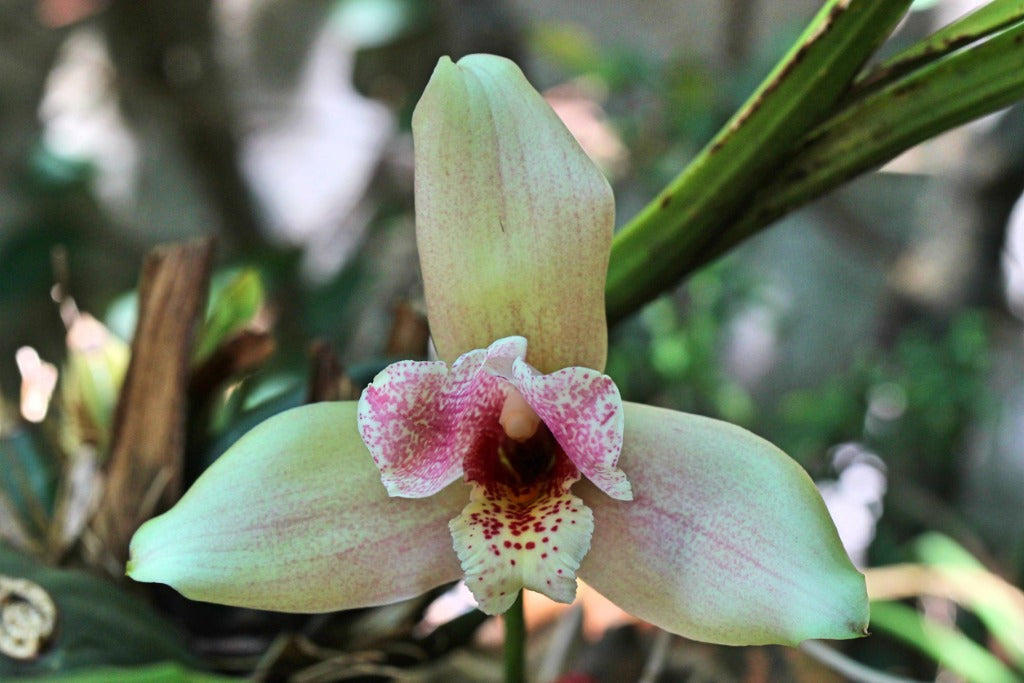
Exquisite orchid arrangements are truly a sight to behold. Collecting and growing exotic orchid plants, on the other hand, take your love for these beautiful flowers a notch higher. Lycaste orchids from the New World Tropics are another orchid genus worth discovering and exploring. Let’s learn more about the lovely Lycaste orchids.
Lycaste Orchids Fast Facts
Botanical Name: Lycaste (lye-KASS-tee)
Abbreviation in horticulture: Lyc.
Etymology of the orchid genus name: Named after Princess Lycaste, the Greek nymph and daughter of King Priamos of the Trojans
Family: Orchidaceae
Subfamily: Epidendroideae
Tribe: Maxillarieae
Subtribe: Lycastinae
Number of recognized species: 31 to 53 orchid species, 3 to 14 natural orchid hybrids, depending on source
Type species: Lycaste plana Lindley 1842
Origin/Distribution: Central America, West Indies, South American Andes
Growing classification: Sympodial, terrestrial, and lithophyte orchids
Blooming season: Mostly spring to the summer season, depending on the specific orchid species
Skill level: Recommended for beginners to advanced orchid growers
Temperature: Cool to intermediate
Birth Orchid: February
Flower meaning: A gentle and pure heart
Lycaste Orchid Plant Info
Lycaste orchids are an incredibly beautiful genus. It has up to 53 unique orchid species distributed all throughout the New World Tropics, from Central America, West Indies, South America, Mexico, Carribean, Peru, and Bolivia. Lycaste orchid species that can either be deciduous or evergreen. Natural habitats can vary from lowlands and at peak elevations 6000 feet. They have characteristically large, waxy, and triangular-shaped orchid blooms with a pleasant fragrance. They have ovate, thick, and plicate leaves that remain after their flowering phase.
List of Lycaste Orchid Species
Based on the AOS, in 2007, the World Checklist of Monocotyledons recognizes 31 species and 3 natural hybrids. Here is a list of the recognized species of Lycaste orchids.
- Lycaste angelae Oakley 2008
- Lycaste aromatica [Graham ex Hooker] Lindley 1843
- Lycaste x balliae Sander ex Rolfe 1898
- Lycaste bradeorum Schltr. 1923
- Lycaste bruncana Bogarín 2007
- Lycaste campbellii C. Schweinf. 1949
- Lycaste candida Lindl. & Paxton 1851
- Lycaste cochleata Lindl. & Paxton 1850-1
- Lycaste consobrina Rchb.f 1852
- Lycaste crinita Lindl. 1844
- Lycaste deppei [Lodd.]Lindley 1843
- Lycaste dowiana Endr. & Rchb.f. 1874
- Lycaste fuscina Oakeley 2008
- Lycaste × groganii E.Cooper 1931
- Lycaste guatemalensis Archila 1999
- Lycaste Jack Hort 1995
- Lycaste lasioglossa Rchb. f. 1872
- Lycaste leucantha [Klotsch]Lindl. 1851
- Lycaste lucianii Linden ex Mast. 1893
- Lycaste luminosa Oakeley 1991
- Lycaste macrobulbon Lindl. 1850-1
- Lycaste macrophylla (Poepp. & Endl.) Lindl. 1842
- Lycaste measuresiana (B.S.Williams) Oakeley 2007
- Lycaste x michelii Oakeley 1993
- Lycaste x niessenii Oakley 2007
- Lycaste occulta Oakeley 2007
- Lycaste panamanensis (Fowlie) Archila 2002
- Lycaste powellii Schltr. 1922
- Lycaste schilleriana Rchb. f. 1855
- Lycaste skinneri [Batem. ex Lindley] Lindley 1843
- Lycaste × smeeana Rchb.f. 1883
- Lycaste suaveolens Summerhayes 1931
- Lycaste tricolor (Klotzsch) Rchb. f. 1863
- Lycaste viridescens (Oakeley) Oakeley 2007
- Lycaste xanthocheila (Fowlie) Oakeley 2007
- Lycaste xytriophora Linden & Rchb. f. 1872
Lycaste to Ida Orchid Genus
According to the American Orchid Society, the Lycaste genus was previously divided into four divisions:
- Fimbriatae
- Deciduosae
- Lycaste
- Longisepalae
DNA analysis supports that the section Fimbriatae (Lycaste barringtoniae, Lycaste ciliata, Lycaste cinnabarina, Lycaste costata, Lycaste dyeriana Lycaste fragrans, Lycaste fulvescens Lycaste gigantea, Lycaste lanipes Lycaste linguella, Lycaste locusta and Lycaste reichenbachii) with spineless pseudobulbs, persistent leaves, green sepals and petals, and a distinct fimbriate lip should be separated from the Lycaste genus. A new genus has been created for it recently called Ida orchids.
Lycaste Orchid Culture
While Lycaste species are considered cloud-forest orchid plants, growing them in parts of Southern California, whether in Los Angeles or Orange County, is easy peasy. All thanks to amazing orchid hybrids that easily adapt to new environments and to SoCal’s pleasant climate, which is conducive to orchid growing, most of the year.
The informative book, Understanding Orchids: An Uncomplicated Guide to Growing the World's Most Exotic Plants, recommends the following as excellent choices for starting out with Lycaste orchids:
- Lycaste aromatica
- Lycaste cochleata
- Lycaste deppei
Orchid experts suggest that the culture for Lycaste orchids is similar to the hybrid genus Angulocaste (Lycaste Anguloa).
Because of the amazing diversity of this orchid genus and all orchids in general, we advise that you proactively research to learn more about the specific type of orchids you are planning to take home. This way, you will get a clearer perspective on its growing requirements and you’ll be better equipped in helping it thrive under your care.
In the case of Lycaste orchids, the smaller-flowered species from Mexico can be forgiving when grown as an indoor orchid plant as long as they are provided a moisture-retentive potting medium. The same is true for cloud forest orchid plants with big and bold orchid blooms. They can adapt to indoor conditions but will demand higher levels of humidity and more controlled temperature to successfully bloom.
Orchid Care: How to Take Care of Lycaste Orchids
Check out these orchid care FAQS for Lycaste orchids.
How much light do Lycaste orchids need?
Depending on the type of Lycaste orchids, the light requirement varies. According to the AOS, deciduous orchid species have the same needs as Cattleya orchids with 2,000 to 4,000 foot-candles (50 to 70 percent shade). Evergreen Lycaste orchids, on the contrary, have much less need for light and can go with 1,500 to 2,000 foot-candles (60 to 80 percent shade).
How frequently should I water my orchid?
In summer during its growing season, Lycaste orchids should be watered copiously. Make sure the potting medium has dried out first before watering again. Keep deciduous orchid species dry when they have no leaves, while the evergreen species a bit more moist than normal after showing pseudobulbs. Lycaste orchids are sensitive to leaf spotting or rotting. Avoid watering the leaves.
Do I need to fertilize my orchids?
Most orchids need proper nutrition through fertilization when they are in their growing and blooming phase. Feed Lycaste orchids generously and regularly during this period with a high-nitrogen formulation. The AOS recommends 30-10-10 during summer and then reducing the concentration or changing it to a high-phosphorous orchid fertilizer once the pseudobulbs have come out, which usually happens in autumn.
Orchids in Los Angeles and Orange County
Are you an orchid lover, too?
Orchid Republic boasts of a stunning collection of exquisite orchid arrangements featuring vanda orchids, phalaenopsis orchids, cymbidium orchids, and more. Our chic orchid plants are available for same day flower delivery in Los Angeles and Orange County. Shop online or visit our store to see our gorgeous orchids!
Sources:
Complete Guide to Orchids By Ortho Books
Understanding Orchids: An Uncomplicated Guide to Growing the World's Most Exotic Plants By William Cullin
The American Orchid Society
Jay's Internet Orchid Species Photo Encyclopedia


Thank you for posting this awesome article.
I’m a long time reader but I’ve never been compelled to leave
a comment. I subscribed to your blog and shared this on my Twitter.
Thanks again for a great article! https://aldus.ca
Leave a comment